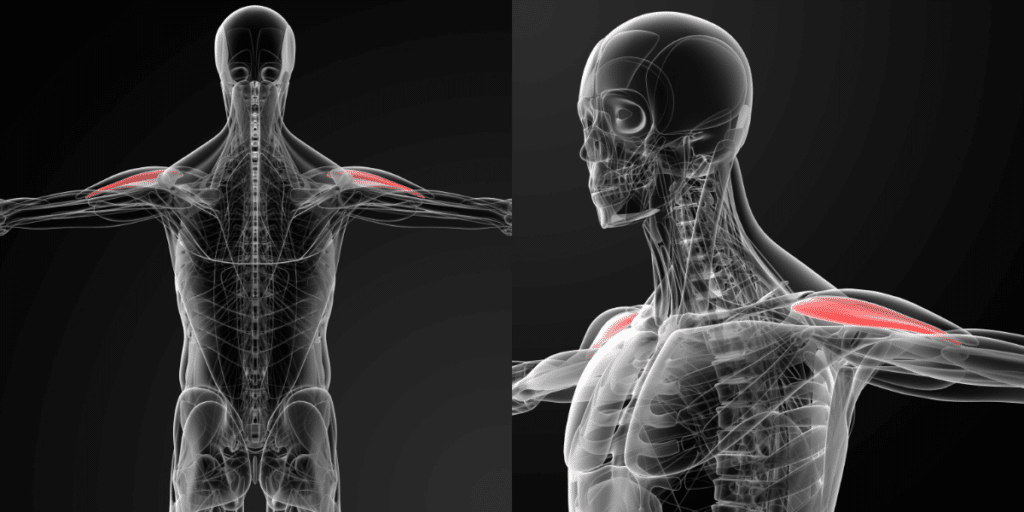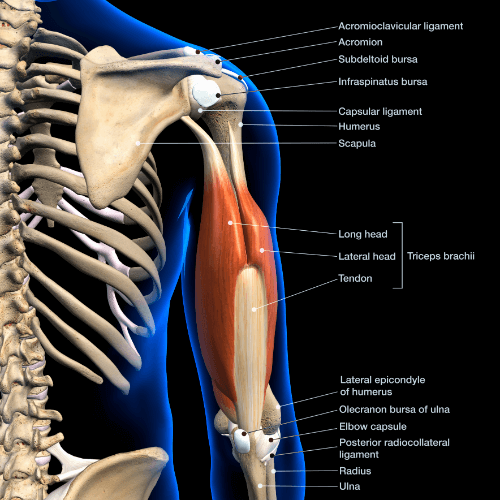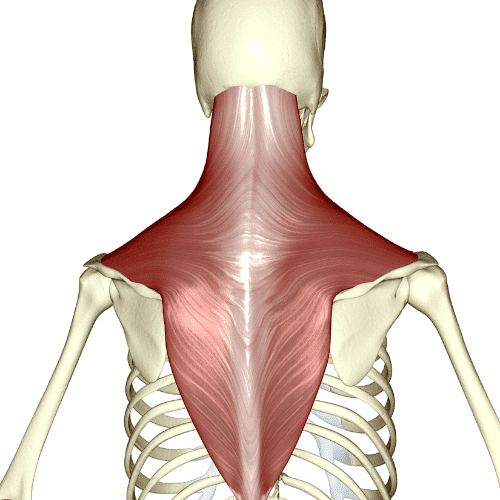Are you finding it difficult to see the rewards of your shoulder press workouts? Do you want to know if you are targeting the right muscles with overhead weights? Or are you constantly worried about injuring your shoulders during this exercise?
If you answered yes to one or more of these questions, then you are in the right place. Many fitness fans face these issues since this is a challenging yet highly rewarding exercise. So to help you out we’ve broken down the different variations of this workout, the muscles they target and how you can make the most of this.
Let’s dig right in.
Jump to:
What is the shoulder press workout?
The shoulder press, also known as the overhead press, is a fundamental strength training exercise in that primarily works the shoulders and arm muscles. It’s a fantastic way to build upper body strength and definition if you are using the correct technique.
Here’s how it works:
- You start with a barbell at shoulder height. Face the palms of your hands forward, and make sure your feet are about hip-width apart for stability.
- Now, you push the weights upward, and as you do, extend your arms fully until they’re locked out overhead.
- Then lower the weights back to the starting position.
It’s a compound exercise that challenges multiple muscle groups simultaneously. These movements engage your shoulder muscles, particularly the front and middle deltoid. The shoulder press also uses your tricep muscles, upper chest muscles, and upper back muscles to stabilise and support the movement.
Practically applying this exercise in your training routine can help you achieve better shoulder strength and stability.
Which muscles are targeted with shoulder press exercise?
The shoulder press exercise uses various muscles in your upper body. Let’s examine the three major muscle groups that are worked during a shoulder press, so we can better understand how they are worked.
1. Anterior deltoid
The anterior deltoid (glenohumeral joint) is the front part of your shoulder muscle, and is responsible for the roundness and definition of your front shoulders.
This muscle comes into action right at the beginning of the shoulder press. As you lift the weights from shoulder height, the anterior deltoid contracts to help push your arms upwards and with overhead motions.

The anterior deltoid is essential for that initial push, and it’s the part that gets that satisfying burn when you’re working on your shoulders.
A strong anterior deltoid can really shape the look of your shoulders and also contribute to functional strength. It’s helpful for tasks like lifting heavy objects or even when you reach overhead during daily activities.
2. Triceps
The triceps are the muscles on the back of your upper arm, consisting of three heads.

The triceps come into play during the latter part of the shoulder press. As you extend your arms fully to lock out the weights overhead, these muscles work hard to help straighten your elbow joint. The more you straighten your arms, the more your triceps are firing.
Strong triceps look attractive, and are also useful for a variety of everyday activities like pushing, punching, and lifting.
3. Trapezius
The upper portion of the trapezius, or traps, is a large muscle that covers your upper back and neck area.
While it may not be as noticeable as the anterior deltoid or triceps, they still play a massive role during the shoulder press. They help to stabilize your shoulder blades and support the lifting motion.

Strong upper traps muscles can help you have a naturally correct posture, and can reduce the risk of injury for most shoulder exercises. In fact, poor posture is often linked to weak traps and/or chest muscles, and a combination of chest and shoulder workouts can help to bring out that upright posture. Proper posture not only looks better but also prevents discomfort and pain associated with poor alignment.
Barbell overhead press vs dumbbell overhead press
Now that we know the basics of the shoulder press exercise, let’s compare two popular variations the barbell overhead press and the dumbbell overhead press. These variations may seem quite similar at first glance, but when done with proper form they have some key differences that can impact your workout results.
With the barbell overhead press, you use a single barbell with weights on each end. You grip the barbell with your hands slightly wider than shoulder-width apart. A barbell can give you more stable range of motion due to its fixed grip, which can help beginners or those focused on lifting heavy weights.
The dumbbell overhead press uses two separate dumbbells, one in each hand. With dumbbells, you have a greater range of motion, which can help target specific areas of your shoulders and adapt the exercise to your body’s natural movement patterns.
Which works your muscles the best?
The barbell overhead press is great for those who want a lot of upper body strength. This workout spreads the weight evenly, which is why it is a great compound exercise that works for multiple muscle groups equally. It places significant emphasis on the anterior deltoid, triceps, and upper traps and can give you stronger shoulders than dumbbells since you can use heavier weights.
Dumbbell overhead presses with proper form require more stabilization compared to a barbell. This means that you engage not only the primary muscles (anterior deltoid, triceps, and upper traps) but also a wider range of secondary muscles throughout your shoulder and core muscles. This can result in a more comprehensive workout for your shoulder girdle and full body.
Overhead press variations & alternatives (and what muscles they target)
Next, let’s go over the other alternatives and variations of this fantastic exercise.
Each of these overhead press variations offers a unique twist on the traditional shoulder press, targeting specific muscles while keeping your workouts effective.
Top tip: A good rep range for beginners is 8-10 at a light weight, while pros with heavier weights should aim for a 5-10 rep range and really focus on the full movements.
Standing dumbbell shoulder press
This exercise predominantly targets the anterior deltoid muscles, triceps, and upper traps, just like the traditional shoulder press. However, because you stand, you have to keep your core tight to stabilize your movements, so it requires a lot more core stability.
How to do it:
- Start in a standing position and hold the dumbbells shoulder height (if you are new to this, then stick to the lighter weights). Make sure your palms are facing forward and your elbows are bent at a 90-degree angle.
- Engage your core for balance and make sure your back is straight.
- Begin the movement by pushing the dumbbells upward until your arm position is fully straight.
- Slowly lower the dumbbells back to the starting position, while you maintain control and avoid any swinging or jerking motions.
- Perform the desired number of repetitions while maintaining proper form.
Seated barbell overhead press
This variation still primarily targets your upper body muscles, but uses less of the lower back and core muscles. It’s an excellent choice if you want to isolate your shoulder muscles without worrying about balance .
Seated overhead presses can be safer for individuals with lower back issues and give better control over heavy weights.
How to do it:
- Begin by setting up a bench with a backrest.
- Sit on the bench with your back firmly against the backrest and your feet flat on the floor.
- Hold the barbell at shoulder height, making sure your hands are in the correct position.
- Make sure your back is in an upright position and think about the core activation.
- Push the barbell upward until your arms are fully extended overhead.
- Lower the weight back down to shoulder level, and maintain control for the entire lift.
- Complete the desired number of repetitions.
Seated dumbbell shoulder press
This variation mimics the standing dumbbell shoulder press, but without too much focus on core strength. It primarily works the anterior deltoid, triceps, and upper traps, and still engages more of your core than barbell presses.
How to do it:
- Position a bench with a backrest and adjust it to a comfortable angle for seated dumbbell presses.
- Sit on the bench with your back against the backrest and your feet flat on the floor.
- Hold a dumbbell in each hand at shoulder height, with your palms facing forward, and your elbows bent at a 90-degree angle.
- Keep your back straight in an upright position, and your core tight.
- Begin the movement by pushing the dumbbells upward until you reach your maximum overhead position.
- Lower the dumbbells back to shoulder height while maintaining control.
- Perform the desired number of repetitions, focusing on the correct technique.
Shoulder press machine
The shoulder press machine primarily targets the anterior deltoid (front shoulder muscle). However, it also engages the lateral deltoid (side shoulder muscle), triceps, and upper traps to a lesser extent.
One of the advantages of the machine is its stability, which means you can isolate and focus on your shoulder muscles.
How to do it:
- Begin by adjusting the seat height and the position of the handles on the machine to align with your shoulder level.
- Take a seated position at the machine with your back firmly against the backrest and your feet flat on the floor.
- Grip the handles with an overhand grip (palms facing forward) and make sure your elbows are bent at a 90-degree angle.
Engage your core for stability. - Push the handles upward until your arms are fully extended overhead.
- Lower the handles back down to shoulder height while maintaining control.
- Perform the desired number of repetitions.
Smith machine press
The Smith machine press also places a significant emphasis on your upper body muscles. It also engages the lateral deltoid and the posterior deltoid (rear delts) to a greater extent due to the fixed barbell path.
How to do it:
- Stand in the Smith machine with your feet shoulder-width apart.
- Adjust the bar to a height where it’s at shoulder level when you’re standing.
- Position yourself under the bar and grip it with your hands slightly wider than shoulder-width apart, palms facing forward.
- Engage your core and keep your back straight.
- Push the bar upward until your arms are fully extended overhead.
- Lower the bar back down to shoulder level while maintaining control.
- Complete the desired number of repetitions with proper form.
Push press
The push press is a dynamic variation of this upper body exercise. It targets the anterior deltoid, triceps, and upper traps, the same as the others. However, what sets it apart is the use of your legs and core as well. The leg drive uses the quadriceps, hamstrings, and glutes, while your core muscles help stabilize your body for the explosive lift.
How to do it:
- Start with the barbell at shoulder level, with your palms facing forward and your feet about hip-width apart.
- Engage your core and keep your back straight.
- Slightly bend your knees to create tension in your legs as if you are just lowering down into the squat position.
- As you push the barbell upward with your arms, simultaneously extend your legs explosively.
- Once your arms are fully extended, lower the barbell back to shoulder height with control.
- Perform the desired number of repetitions.
The best benefits of this workout
Now that we’ve covered the nitty-gritty details of the overhead press, it’s time to delve into the exciting part: the benefits of incorporating this exercise into your fitness routine.
Functional training like the upper body workout the over head press gives can help with real-world activities. Think about lifting a heavy suitcase into an overhead compartment or moving furniture around the house. Combining this with other workouts like triceps extensions and handstand push-ups is an excellent exercise routine that’ll give you a balanced shoulder development. Plus, the versatility of this exercise means you can mix it up with different variations, such as standing or seated presses, to keep things interesting.
Some variations of the overhead press, like the push press, engage not only your upper body muscles but also your legs and core. This full-body involvement makes it a well-rounded exercise that targets multiple muscle groups simultaneously.
FAQs
Does shoulder press work all 3 heads?
Shoulder presses primarily target the anterior deltoid (front deltoid). While they also engage the lateral head (side deltoid) and to a lesser extent, the posterior deltoid, the emphasis is on the anterior deltoid. To fully target all three heads of the deltoids, it’s recommended to use a variety of shoulder exercises in your workout routine.
Which press is best for bigger chest?
If your goal is to develop a bigger chest, exercises that specifically target the chest muscles (pectoralis major and minor) are most effective. Some of the best exercises for a big chest size are the bench press, incline bench press, dumbbell bench press, and chest flies. These have a different range of muscle activation and require you to use barbells on a flat bench as compared to standing overhead.
Which shoulder press is most effective?
The most effective shoulder press variation depends on your fitness goals and personal preferences. Both the barbell overhead press and dumbbell overhead press are effective for building shoulder strength and size. The choice between them often comes down to factors like comfort, individual body mechanics, and whether you prefer the stability of a barbell or the range of motion provided by dumbbells.
What do shrugs work?
Shrugs help build and define the upper traps, contributing to a more muscular and well-rounded upper back and neck area as well as shoulder stability. They strengthen the upper traps and also reduce tension and discomfort in the neck and upper back region. They are also great as a shoulder mobility exercise and you don’t need an Olympic weightlifting team or a training program to do them, as you can do them anywhere.
Does the overhead press damage your shoulder muscles?
No, when performed with proper form and technique, the overhead press does not typically damage shoulder muscles. In fact, it can strengthen and condition the shoulder muscles, leading to improved shoulder health. However, using improper form, lifting excessive weights, or overtraining without adequate recovery can increase your injury risk. It is best to leave the heavier loads for those with overhead press exercise experience and rather go for something realistic that aligns with your fitness level and goals.















